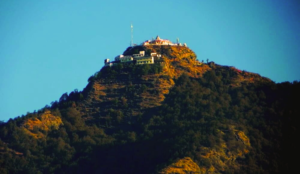Patal Bhuvaneshwar Cave Temple-Tucked away in the embrace of the Kumaon hills in Uttarakhand, India, the Patal Bhuvaneshwar Cave Temple stands as a testament to nature’s artistry and human devotion.
Carved into the heart of the Earth, this sacred sanctuary has beckoned explorers, pilgrims, and seekers for centuries. With its intriguing legends, awe-inspiring geological formations, and spiritual resonance, Patal Bhuvaneshwar invites us to unravel its secrets.
Mythical Origins and Significance
Unveiling the Mythical Tapestry
As one ventures into the cave’s depths, they step into a realm steeped in Hindu mythology.
The name “Patal Bhuvaneshwar” itself is imbued with meaning. “Patal” refers to the netherworld, the subterranean realm beneath the Earth’s surface, while “Bhuvaneshwar” signifies Lord Shiva, the cosmic creator and destroyer.
This confluence of names underscores the belief that this cave is a direct passage to the divine.
Abode of the Deities
According to ancient texts, Patal Bhuvaneshwar is believed to be the abode of several deities. Among them, Lord Shiva takes center stage, serving as the reigning deity of this subterranean realm.
It is said that devotees who enter the cave are blessed with an opportunity to connect directly with Lord Shiva, experiencing a communion between the mortal and the divine.
A Pilgrimage of Redemption
Legend has it that a visit to Patal Bhuvaneshwar holds profound significance for spiritual seekers.
It is believed that entering the cave’s depths and paying homage to the deities residing within can absolve one of their sins and facilitate their journey towards moksha, or liberation from the cycle of birth and death.
This promise of spiritual redemption draws devotees from far and wide, each seeking to cleanse their soul within the cave’s sanctified embrace.
Ancient Scriptures and Epics
Patal Bhuvaneshwar finds its place in various Hindu scriptures and epics.
The revered Skanda Purana, for instance, contains references to this sacred cave, cementing its status as a site of spiritual veneration.
These texts amplify the temple’s significance, narrating stories of celestial beings, sages, and divine interventions that have graced its hallowed chambers.
The Confluence of Myth and Reality
Patal Bhuvaneshwar’s mythical origins extend beyond its geological formation. Its significance reverberates through time, as pilgrims and visitors continue to seek solace and enlightenment within its cavernous depths.
The belief in the cave’s direct connection to Lord Shiva and its association with profound spiritual experiences reinforce its status as a conduit between the terrestrial and the divine.
A Living Testament
Today, as devotees and explorers alike descend into Patal Bhuvaneshwar, they become part of a living tradition that spans centuries.
The temple’s mythical origins continue to shape the experiences of those who tread its ancient passages, bridging the gap between the stories of old and the seekers of today.
It stands as a reminder that myths are not mere tales of the past; they are narratives that live on through the reverence and devotion of those who uphold them.
Journey to the Depths: Exploring the Cave
Entering the Subterranean Portal
The journey to the heart of Patal Bhuvaneshwar Cave Temple is a passage into the unknown, a descent into the enigmatic depths that have captured the human imagination for centuries.
As you stand before the cave’s unassuming entrance, you are poised to embark on a pilgrimage that transcends the physical realm and delves into the spiritual and mystical.
A Step into Another World
The initial steps into the cave’s interior transport you into a world of darkness and mystery. The narrow passageway winds its way downward, leading you deeper into the Earth’s embrace.
The air grows cooler, and the echoes of your footsteps bounce off the ancient walls, creating an eerie symphony that resonates with the footsteps of countless pilgrims who have trod this path before.
Nature’s Artistry Revealed
As you journey further into the cave, the darkness begins to give way to dimly lit chambers adorned with nature’s intricate handiwork.
Stalactites hang like chandeliers from the ceiling, while stalagmites rise gracefully from the ground, creating a mesmerizing dance of forms.
These formations, shaped over millennia by the slow drip of mineral-rich water, resemble sculptures crafted by celestial hands.
A Sanctuary of Reflection
The cave’s interior offers a sanctuary for introspection and meditation. The rhythmic sound of water droplets echoes like a melodic chant, inviting you to silence your mind and immerse yourself in the present moment.
The dim lighting and the echo of your breath create an atmosphere that feels suspended in time—a space where the boundaries between the mundane and the divine blur.
Nooks and Crannies of Wonder
As you navigate the passages, you encounter hidden alcoves and chambers, each revealing its unique wonders.
Some nooks bear the semblance of deities, etched by nature’s patient craftsmanship.
Others unveil the play of light and shadow on mineral formations, conjuring a sense of ethereal beauty that ignites your imagination.
Reverence and Awe
At the heart of Patal Bhuvaneshwar lies the central sanctum, where a sacred Shiva lingam stands as a focal point of devotion. The air is thick with reverence, and the flickering flames of oil lamps cast a warm glow on the ancient idol.
Here, pilgrims and visitors alike find themselves drawn into a space that transcends time, a space where the earthly and the divine converge.
A Journey of Transformation
As you conclude your journey through Patal Bhuvaneshwar’s depths, you emerge from the cave transformed.
The exploration of its passages becomes a metaphorical journey through the layers of your being-an expedition into the recesses of your soul.
The experience lingers, a testament to the profound connection between the human spirit and the mysteries of the universe.
Sculptural Marvels within the Cavern
A Glimpse into Nature’s Workshop
As you venture deeper into the mystical embrace of the Patal Bhuvaneshwar Cave Temple, you are greeted by a sight that leaves you awestruck and humbled.
The cave’s interior becomes a canvas upon which nature has painted an exquisite masterpiece of sculptural marvels. Stalactites and stalagmites, shaped over millennia by the patient hands of water and minerals, stand as silent witnesses to the artistry of the Earth itself.
Nature’s Craftsmanship Unveiled
Every step you take within the cavern reveals a new marvel, a sculpture that tells a story of time’s gentle touch. Stalactites, icicle-like formations that hang gracefully from the ceiling, appear like nature’s chandeliers, suspended in midair.
They are the result of countless droplets of water, each leaving behind a trace of minerals, gradually building intricate shapes that defy imagination.
Stalagmites: Rising from the Depths
On the cave floor, stalagmites emerge like ancient sentinels, rising steadfastly toward the heavens. These formations mirror their counterparts above as if engaged in a silent conversation across the expanse of the cave.
Over millennia, water droplets carrying minerals have fallen to the ground, layer upon layer, creating towering sculptures that evoke a sense of timelessness.
Whispers of Divinity
Amidst these natural sculptures, devotees and explorers alike discern forms that resemble deities and celestial beings. The craftsmanship of nature gives rise to figures that seem to spring from the realm of myths and legends.
Faces emerge from the rock, their features so intricately detailed that one can’t help but feel the presence of the divine in every contour and curve.
The Central Sanctum: A Focal Point of Devotion
At the heart of the cave, the central sanctum stands as a testament to both nature’s artistry and human devotion.
Here, a sacred Shiva lingam takes center stage, radiating an aura of sanctity that permeates the chamber.
The sculptural marvels surrounding the lingam appear as if divine hands meticulously carved them to adorn the deity’s abode.
A Journey Through Myth and Time
Exploring the sculptural marvels within the cavern is akin to embarking on a journey through the annals of history and mythology.
The formations resemble not only deities but also symbols that echo ancient stories and cosmic truths. It’s as if nature itself has become a storyteller, etching tales of creation and transcendence into the very walls of the cave.
Awe and Inspiration
The sight of these natural sculptures evokes a sense of wonder that transcends the ordinary.
Each formation is a testament to the delicate dance between water and rock, a dance that has unfolded over countless years.
As you stand amidst these sculptures, you are reminded of the boundless creativity of the universe and the profound interconnectedness of all things.
Geological and Natural Splendors
A Geological Masterpiece
Beneath the surface of the Earth’s embrace lies a hidden gem that showcases the Earth’s geological evolution over eons.
Patal Bhuvaneshwar Cave Temple is not merely a place of worship; it is a living testament to the intricate dance between water, minerals, and time itself.
Its chambers and corridors are adorned with geological formations that astound the senses and kindle the imagination.
The Dance of Water and Rock
As you venture deeper into the cave’s labyrinthine passages, you bear witness to the remarkable effects of water’s patient persistence.
Over countless millennia, droplets of water laden with minerals have trickled from the cave’s ceiling, leaving behind traces that have crystallized into delicate formations.
The result is an array of stalactites and stalagmites that stretch like frozen waterfalls, capturing the essence of motion within their stillness.
A Symphony of Colors
The cave’s walls shimmer with mineral deposits, creating a mesmerizing tapestry of colors that shift and change with the play of light.
Shades of ivory, ochre, and rust intermingle, giving the cave an otherworldly appearance.
This natural canvas, painted by the hand of geological processes, invites visitors to contemplate the beauty born from the marriage of Earth’s elements.
Mineral Marvels
Among the geological splendors, helictites stand out as some of the cave’s most intriguing formations.
These delicate, twisting growths seem to defy gravity as they meander in all directions.
Helictites are true sculptures of nature, formed as water navigates the twists and turns of underground passages, leaving behind its mineral cargo in a mesmerizing display of organic artistry.
A Window into Earth’s History
The formations within Patal Bhuvaneshwar are not merely aesthetic marvels; they hold within them a chronicle of Earth’s past. Layers of minerals provide a glimpse into the changing geological conditions that have shaped the planet.
These formations, like the pages of a geological textbook, narrate stories of shifting tectonic plates, changing climates, and the slow but relentless passage of time.
A Testament to Patience
Geological processes are defined by their gradual nature, and the formations within the cave are a testament to the patience of the Earth itself.
Each drop of water that contributes to the cave’s sculptures is a silent architect of beauty, shaping the cave’s contours one mineral-laden journey at a time.
This patient craftsmanship is a reminder that the most exquisite creations often require the passage of ages.
Reflections of the Divine
Amid this geological symphony, it is easy to see reflections of the divine.
The intricate formations, reminiscent of delicate jewelry, evoke a sense of reverence and awe.
They remind us that the Earth itself is a work of art, sculpted by forces both seen and unseen, and that the act of exploration becomes a form of communion with the natural world.
Local Culture and Cuisine
A Tapestry of Local Life
Beyond the subterranean marvels of Patal Bhuvaneshwar Cave Temple lies a world rich in culture, tradition, and the warmth of human connection.
The villages surrounding the temple offer a glimpse into the lives of the Kumaoni people, whose heritage and way of life are interwoven with the sacred sanctuary. Exploring this cultural tapestry and savoring local cuisine becomes an integral part of the journey.
The Rhythms of Kumaoni Life
As you step into the villages that dot the landscape around Patal Bhuvaneshwar, you become immersed in the rhythms of Kumaoni life.
The air is filled with the melodies of traditional music, and vibrant festivals celebrate the changing seasons and the bounties of the land.
The people’s warm hospitality and genuine smiles welcome you into their world, offering a glimpse into their time-honored traditions.
Traditional Crafts and Artistry
Local craftsmanship flourishes in these villages, with artisans practicing age-old skills that have been passed down through generations.
Intricately carved wooden items, vibrant textiles, and exquisite handicrafts bear the imprints of Kumaoni artistry.
Engaging with these artisans not only supports local livelihoods but also provides a window into the creativity and dedication that define Kumaoni culture.
Celebrations of Faith
Religion is deeply ingrained in Kumaoni culture, and you may have the opportunity to participate in local festivals and rituals that celebrate the divine.
Colorful processions, enchanting folk performances, and age-old ceremonies offer a chance to witness the fusion of spirituality and celebration.
These gatherings are a reminder that the connection between the spiritual and the everyday is seamless in this vibrant community.
A Gastronomic Journey
No exploration of local culture is complete without savoring the culinary delights that the region has to offer.
Kumaoni cuisine, rooted in tradition and influenced by the local terrain, tantalizes the taste buds with its unique flavors and ingredients.
From piping hot stews and lentil dishes to locally grown vegetables and fragrant spices, each meal is a testament to the region’s bounty.
Flavors of the Land
Kumaoni cuisine reflects the simplicity and authenticity of rural life.
The use of locally sourced ingredients ensures that every dish is a celebration of the land’s offerings. Bhatt ki Churkani, a spiced black bean curry, and Aloo Ke Gutke, stir-fried potatoes with regional spices, are just a glimpse of the culinary treasures that await.
These flavors provide a direct connection to the soil and the culture it nurtures.
A Journey of Culinary Discovery
Sampling Kumaoni cuisine is not just a culinary experience; it is a journey of discovery and connection. Sharing a meal with the locals is an opportunity to learn about their traditions, stories, and way of life.
As you savor the flavors and textures unique to this region, you are immersing yourself in a centuries-old tradition that reflects the harmony between humans and their environment.
Sustaining Traditions
By engaging with the local culture and cuisine, you become a part of the effort to sustain and preserve Kumaoni’s heritage.
Your appreciation for their traditions encourages the continuation of practices that define their identity.
Your presence contributes to the resilience of a way of life that is deeply connected to the land, the community, and the spiritual.
Visiting Essentials: Practical Information
How to Get There
First things first, let’s talk about how to get to Patal Bhuvaneshwar. You can start your trip in a town called Chaukori. If you’re coming by train, get off at Kathgodam station. From there, you can take a taxi or a local bus to reach the temple. The ride itself is like an adventure, with beautiful views of the hills.
Dress Up Smart
Since you’re visiting a special place, it’s a good idea to dress a bit respectfully.
Wear comfy shoes because you’ll be doing some walking. Also, it can get a bit chilly inside the cave, so a light sweater or jacket might come in handy.
And don’t forget to bring a scarf or shawl to cover your head when you’re in the temple area.
Explore the Cave Wonders
Now, let’s talk about the super cool part – the cave itself! It’s like a natural art gallery with rock formations that look like sculptures. Stalactites hang from the ceiling like icicles, and stalagmites rise from the ground like little mountains.
They’ve been formed over a long time by water and minerals. You can even see shapes that look like gods and mythical creatures!
Be a Responsible Explorer
While you’re exploring the cave, remember to follow the rules and be respectful. Take cool pictures, but be careful not to touch anything.
The formations are delicate and need to be protected. Also, you might see people praying and lighting oil lamps – it’s part of the temple’s tradition. You can watch and learn how they do it if you want!
Say Hi to the Locals
The people who live around the temple are nice and friendly. You can learn a lot from them about their culture and traditions.
Maybe you’ll even get to see some local crafts and art. It’s a chance to make new friends and experience a different way of life.
Time to Visit
The temple is open from the morning until the afternoon, so it’s a good idea to go early to avoid big crowds.
The pathways inside are well-maintained, but some places might be a bit narrow, so keep that in mind if you’re bringing grandparents or younger siblings.
Keep It Clean and Green
Let’s all be responsible travelers and take care of the environment. Bring a reusable water bottle and avoid using plastic.
Don’t leave any trash behind, and respect nature by not picking flowers or disturbing animals.
Have a Blast!
So, there you have it, adventurers! Patal Bhuvaneshwar Cave Temple is waiting for you with its amazing rocks, cool sculptures, and fascinating history.
Choosing the Perfect Stay
Planning a visit to Patal Bhuvaneshwar and looking for a cozy place to stay? No worries, we’ve got you covered! Whether you’re an adventurer seeking budget options or a traveler looking for luxury, several hotels near Patal Bhuvaneshwar offer comfortable stays and a chance to relax after your exciting exploration.
1. Bhuvneshwar Eco Lodge
If you’re a nature lover, Bhuvneshwar Eco Lodge might be just the place for you.
Surrounded by lush greenery and located close to the temple, this lodge offers a serene atmosphere and eco-friendly accommodations.
Wake up to the chirping of birds and enjoy a cup of tea with a view of the hills. It’s a great option for those who want to be close to nature.
2. Chaukori Hill Resorts
For a breathtaking view of the Himalayas, Chaukori Hill Resorts is a fantastic choice.
Situated a short drive away from Patal Bhuvaneshwar, this resort offers comfortable rooms, warm hospitality, and panoramic vistas of the snow-capped peaks.
It’s a place where you can unwind and soak in the beauty of the mountains.
3. The Misty Mountains Retreat
Looking for a retreat that combines comfort with a touch of luxury? The Misty Mountains Retreat is nestled in the heart of nature and provides cozy rooms with modern amenities.
The serene surroundings and personalized service make it a perfect place to relax and rejuvenate after your cave exploration.
4. Ojaswi Himalayan Resort
If you’re seeking a blend of comfort and cultural immersion, Ojaswi Himalayan Resort is a great option.
Located in the nearby village, it offers well-appointed rooms and a chance to experience local culture up close.
You can enjoy traditional Kumaoni meals and interact with the friendly locals during your stay.
5. Hill Crest Resort
For those who appreciate modern comforts, Hill Crest Resort is a stylish option near Patal Bhuvaneshwar.
With well-furnished rooms, a restaurant serving delicious cuisine, and amenities like free Wi-Fi, this resort provides a comfortable base for your adventures.
Tips for Booking
- Book in Advance:
Since Patal Bhuvaneshwar is a popular destination, it’s a good idea to book your accommodation in advance, especially during peak seasons. - Check Reviews:
Before making a reservation, read reviews from other travelers to get an idea of the experiences they had at the hotel. - Location Matters:
Consider the location of the hotel in Patal Bhuvaneshwar. A closer stay will save you travel time and allow you to make the most of your visit. - Amenities:
Depending on your preferences, choose a hotel that offers amenities that are important to you, such as Wi-Fi, hot water, and room service. - Budget-Friendly Options:
If you’re traveling on a budget, explore guesthouses and lodges in the nearby villages for a more affordable stay.
Conclusion
Patal Bhuvaneshwar Cave Temple stands as a testament to the enduring synergy between nature, spirituality, and human endeavor.
As you emerge from the depths of the cave, you’ll carry with you a sense of having traversed not only physical passages but also the corridors of history and faith.
This hidden gem in the heart of Uttarakhand leaves an indelible mark on all who dare to venture within its mystical embrace.
FAQS
1. How old is Patal Bhuvaneshwar Cave Temple?
Patal Bhuvaneshwar Cave Temple dates back thousands of years, with historical and mythological references suggesting its ancient origins.
2. Is the cave temple accessible year-round?
Yes, the cave temple is open throughout the year, allowing visitors to experience its mystical beauty in every season.
3. Are there any local legends associated with the cave?
Indeed, local legends speak of Lord Shiva imparting wisdom and the sage Adi Shankaracharya meditating here, infusing the cave with spiritual energy.
4. What’s the significance of the limestone Shivalinga?
The limestone Shivalinga is a revered manifestation of Lord Shiva, attracting devotees seeking blessings and a deep spiritual connection.
5. Can children and elderly visitors explore the cave comfortably?
While the cave’s terrain might pose some challenges, guides ensure a safe and comfortable exploration for visitors of all ages, making it accessible to children and the elderly.





